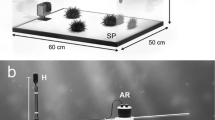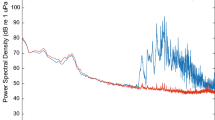Summary
To study the diets of individual animals in the context of intraspecific resource partitioning, it is desirable to detect what individuals are eating without disturbing them. Animals such as slow-moving molluscs on two-dimensional algal foods would be convenient to study, but the mouth is usually difficult to see, especially with limpets. However, one can often hear how an herbivorous mollusc is feeding. Even when the mouth region can be checked for feeding movement, feeding noises can indicate to what degree a mollusc is “licking” microscopic material off the surface of a plant versus biting into the plant, though licking microscopic material off the plants seems to be rare. Noises also indicate the food's texture, identifying the food species when several different algae are near the mollusc's mouth. Comparing various molluscan taxa, differences in radular structure and movement are associated with different feeding noises, even while different molluscs are eating the same alga. Sound thus aids in specifying which species are feeding where molluscs are close together.
Feeding is most common on wet surfaces at night. While the molluscs are above water or less than 5 cm deep in calm water, several listening methods are useful after some practice. Even the unaided ear can hear emerged molluscs rasping resonant kelps. One can detect rasping by molluscs greater than 1 cm in length by gently contacting the alga closest to the mouth with a stethoscope or with a gum rubber tube sealed against one's ear. A cassette tape recorder with a contact microphone and headphones is useful for both emerged and submerged animals. Representative feeding noises have been documented using oscillograms from tape recordings. Analogous sounds in both terrestrial and marine environments can be useful in numerous behavioral studies.
Similar content being viewed by others
References
Arnold, J.M.: Some aspects of hole-boring predation by Octopus vulgaris. Amer. Zool. 9, 991–996 (1969)
Beppu, W.J.: A comparison of carbohydrate digestion capabilities in four species of Acmaea. The Veliger 11 (Suppl.), 98–101 (1968)
Berrie, W.R., Devereaux, M.W.: Identification and location of carbohydrates in the intestinal tract of Tegula funebralis (Mollusca: Gastropoda). The Veliger 6 (Suppl.), 20–24 (1964)
Busnel, R.G., Dziedzic, A.: Rhythme du bruit de fond de la mer à proximité des côtes et relations avec l'activité acoustique des populations d'un Cirrepède fixé immergé. Cahiers Oceanographiques, No. 5, 293 (1962)
Carriker, M.R., Van Zandt, D.: Predatory behavior of a shell-boring muricid gastropod. Behavior of marine animals: current perspectives in research. Vol. 1, invertebrates (H.E. Winn, B.L. Olla, eds.), pp. 157–244. New York: Plenum Publ. 1972
Carriker, M.R., Martin, B.: Analysis of shell boring behavior of muricid gastropods, Urosalpinx cinerea (Say) by means of color motion pictures and microhydrophone recording of radular sounds. Amer. Zool. 5, 645 (1965)
Dayton, P.K., Rosenthal, R.J., Mahen, R.C., Antezana, T.: Population structure and foraging biology of the predaceous Chilean asteroid Meyenaster gelatinosus and the escape biology of its prey. Mar. Biol. 39, 361–370 (1977)
Frank, P.W.: The biodemography of an intertidal snail population. Ecology 46, 831–844 (1965)
Hewatt, W.G.: Ecology studies on selected marine intertidal communities of Monterey Bay. Ph.D. Thesis, Stanford Univ. Stanford, California (1934)
Jobe, A.: A study of morphological variation in the limpet Acmaea pelta. The Veliger 11 (Suppl.), 69–72 (1968)
Jones, J.G.: A method for observation and enumeration of epilithic algae directly on the surface of stones. Oecologia 16, 1–8 (1974)
Kitting, C.L.: Foraging of individuals within the limpet species, Acmaea (Notoacmea) scutum at Monterey Bay, California, and the consequences on their mid-intertidal algal foods. Ph.D. Thesis, Stanford Univ., Stanford, California (1978)
Kitting, C.L.: Food selection of individual limpets that tend to maintain a particular mixed diet, and the consequences on their mid-intertidal algal foods. (unpublished manuscript)
Kumpf, H.E.: Use of underwater television in bio-acoustic research. In: Marine bio-acoustics (W.N. Tavolga, ed.), pp. 45–47. New York: MacMillan Co., 1964
MacArthur, R.H., Wilson, E.O.: The theory of island biogeography. Princeton, New Jersey: Princeton Univ. Press. 1967
Nicotri, M.E.: Resource partitioning, grazing activities, and influence on the microflora by intertidal limpets. Ph.D. Thesis, Univ. Washington, Seattle, Washington (1974)
Phillips, D.W.: Distance chemoreception-triggered avoidance behavior of the limpets Acmaea (Collisella) limatula and Acmaea (Notoacmea) scutum to the predatory starfish Pisaster ochraceus. J. Exp. Zool. 191, 199–210 (1975)
Pieron, H.: Contribution a la Biologie de la patelle et de la calyptrée. L'ethologieles phénomènes sensoriels. Bull. scient. Fr. Belg. 7e ser. 43, 183–202 (1909)
Pyke, G.G., Pulliam, H.R., Charnov, E.L.: Optimal foraging: A selective review of theory and tests. Quart. Rev. Biol. 52, 137–154 (1977)
Roughgarden, J.: Evolution of niche width. Amer. Natur. 106, 638–718 (1972)
Roughgarden, J.: Niche width: biogeographic patterns among Anolis lizard populations. Amer. Natur. 108, 429–442 (1974)
Schoener, T.W.: Theory of feeding strategies. Ann. Rev. Ecol. Syst. 2, 369–404 (1971)
Thorne, M.: Homing in the chiton Acanthozostera gemmata (Blainville). Proc. R. Soc. Qd. 79, 99–108 (1967)
Author information
Authors and Affiliations
Rights and permissions
About this article
Cite this article
Kitting, C.L. The use of feeding noises to determine the algal foods being consumed by individual intertidal molluscs. Oecologia 40, 1–17 (1979). https://doi.org/10.1007/BF00388806
Received:
Issue Date:
DOI: https://doi.org/10.1007/BF00388806




